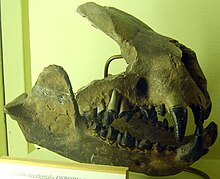9-메틸β-카르보린
9-Methyl-β-carboline | |
| 이름 | |
|---|---|
| 우선 IUPAC 이름 5-메틸-5H-피리도[3,4-b]인돌 | |
기타 이름
| |
| 식별자 | |
3D 모델(JSmol) | |
| 켐스파이더 | |
| 메쉬 | C529608 |
PubChem CID | |
| |
| |
| 특성. | |
| C12H10N2 | |
| 몰 질량 | 182.226 g/120−1 |
달리 명시되지 않은 한 표준 상태(25°C[77°F], 100kPa)의 재료에 대한 데이터가 제공됩니다. | |
9-메틸β-카르볼린(9-Me-BC)은 β-카르볼린 계열의 복소환식 아민 및 연구용 화학물질이다.[1]
화학
9-Me-BC는 분자식이12102 CHN인 β-카르보린의 메틸화 유도체이다.
프리베이스 β-카르보린(노르하르마네)[citation needed]에 대해 에슈바일러-클라크 반응을 수행하여 조제할 수 있다.
생물학적 영향
도파민 작동성 뉴런 세포 배양에 대한 시험관내 연구는 티로신 수산화효소 및 관련 전사 인자의 발현 증가, 신경계 외 성장 증가, 만성 로테논 투여 후 뉴런 재생 및 염증성 사이토카인의 [1]발현 감소를 보여주었다.일차 중뇌의 도파민 작동성 뉴런 세포 배양의 연구에서, 그 물질과 전사 요소 도파민으로 활성화되는 분화와 관련된 높은 수준의 생산 차별화된 도파민 작동성 뉴런의 수는 증가했다.[2]9-Me-BC도 도파민으로 활성화되는 신경독 MPP+을 신경독으로, 전조는 소액 지불 처리 프로토콜의 산화 작용을 억제하였습니다.체외의[3]
vivo에Rodent 연구, 방사형 미로 시험의 공간 학습 성과 향상되고 hippocampus,[4]의 치상 방추상 회의 앞부분뿐만 아니라 티로신 수소수 산화 효소의 수 MPP+을 주사한 후 reduce 왼쪽 선조체에서도 뉴런을 표현하는 복원의 수지상 결정 결과 증가 높은 해마의 도파민 수준을 보여 주었다.d가 현장 흙e 파킨슨병의 [5]동물 모델에서 그러한 세포의 수를 50%까지 증가시킨다.
9-Me-BC는 모노아민 산화효소 A와 모노아민 산화효소 B의 인히비터이며 파킨슨병 [6]치료에 대한 추가 연구를 위해 제안되었다.
「 」를 참조해 주세요.
레퍼런스
- ^ a b Polanski, W; Enzensperger, C; Reichmann, H; Gille, G (2010). "The exceptional properties of 9-methyl-β-carboline: Stimulation, protection and regeneration of dopaminergic neurons coupled with anti-inflammatory effects". J Neurochem. 113 (6): 1659–1675. doi:10.1111/j.1471-4159.2010.06725.x. PMID 20374418.
- ^ Hamann, J; Wernicke, C; Lehmann, J; Reichmann, H; Rommelspacher, H; Gille, G (2008). "9-Methyl-β-carboline up-regulates the appearance of differentiated dopaminergic neurones in primary mesencephalic culture". Neurochem. Int. 52 (4–5): 688–700. doi:10.1016/j.neuint.2007.08.018. PMID 17913302. S2CID 24226033.
- ^ Herraiz, T; Guillén, H (2011). "Inhibition of the bioactivation of the neurotoxin MPTP by antioxidants, redox agents and monoamine oxidase inhibitors". Food Chem. Toxicol. 49 (8): 1773–1781. doi:10.1016/j.fct.2011.04.026. hdl:10261/63126. PMID 21554916.
- ^ Gruss, M; Appenroth, D; Flubacher, A; Enzersperger, C; Bock, J; Fleck, C; Gille, G; Braun, K (2012). "9-Methyl-β-carboline-induced cognitive enhancement is associated with elevated hippocampal dopamine levels and dendritic and synaptic proliferation". J Neurochem. 121 (6): 924–931. doi:10.1111/j.1471-4159.2012.07713.x. PMID 22380576.
- ^ Wernicke, C; Hellmann, J; Zieba, B; Kuter, K; Ossowska, K; Frenzel, M; Bencher, NA; Rommelspacher, H (2010). "9-Methyl-beta-carboline has restorative effects in an animal model of Parkinson's disease". Pharmacol Rep. 62 (1): 35–53. doi:10.1016/s1734-1140(10)70241-3. PMID 20360614.
- ^ Polanski, W; Reichmann, H; Gille, G (2011). "Stimulation, protection and regeneration of dopaminergic neurons by 9-methyl-β-carboline: a new anti-Parkinson drug?". Expert Rev Neurother. 11 (6): 845–860. doi:10.1586/ern.11.1. PMID 21651332. S2CID 24899640.
- ^ Vignoni M, Rasse-Suriani FA, Butzbach K, Erra-Balsells R, Epe B, Cabrerizo FM (2013). "Mechanisms of DNA damage by photoexcited 9-methyl-β-carbolines". Org Biomol Chem. 11 (32): 5300–9. doi:10.1039/c3ob40344k. PMID 23842892.


